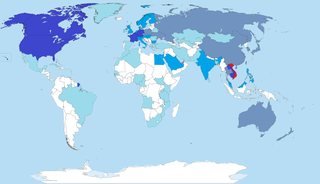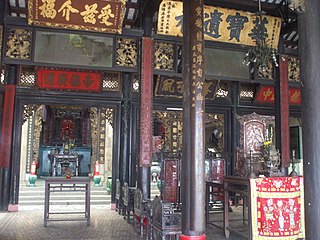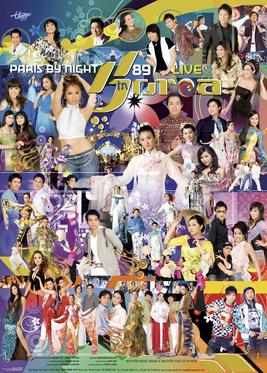
Cabramatta, also abbreviated as Cabra, is a suburb in South Western Sydney, in the state of New South Wales, Australia. Cabramatta is located 30 kilometres (19 mi) south-west of the Sydney central business district, in the local government area of the City of Fairfield.

The flag of South Vietnam was first introduced by the Provisional Central Government of Vietnam, later served as the national flag of the State of Vietnam, and its successor, the Republic of Vietnam from 1948 to 1975 until the fall of Saigon. The design consists of a yellow background with three red horizontal stripes through the middle. It is used to represent the "Vietnamese Heritage and Freedom Flag".

The Division of Fowler is an Australian electoral division in the state of New South Wales.

Overseas Vietnamese refers to Vietnamese people who live outside Vietnam. There are approximately 5 million overseas Vietnamese, the largest community of whom live in the United States.

The Hoa people are the citizens and nationals of Vietnam of full or partial Han Chinese ancestry. Chinese migration into Vietnam dates back millennia but allusions to the contemporary Hoa today mostly refers to people of Chinese ancestry who immigrated to Vietnam during the 18th century, who especially trace their ancestry to various southern Chinese provinces. The Hoa are an ethnic minority group in Vietnam as part of the Chinese community there, and can also be found in other regions such as in the Americas. They may also be called "Chinese-Vietnamese" or "Chinese people living in/from Vietnam" by the Vietnamese.

Vietnamese Canadians are Canadian citizens of Vietnamese ancestry. As of 2021, there are 275,530 Vietnamese Canadians, most of whom reside in the provinces of Ontario, British Columbia, Alberta, and Quebec.
Canley Heights is a suburb of Sydney, in the state of New South Wales, Australia 31 kilometres west of the Sydney central business district, in the local government area of the City of Fairfield and is part of the South-western Sydney region.

Khoa Do, is a Vietnamese-born Australian film director, screenwriter, and philanthropist. He received the Young Australian of the Year Award in 2005.

The Catholic Church in Vietnam is part of the worldwide Catholic Church, under the spiritual leadership of bishops in Vietnam who are in communion with the Pope in Rome. Vietnam has the fifth largest Catholic population in Asia, after the Philippines, India, China and Indonesia. There are about 7 million Catholics in Vietnam, representing 7.4% of the total population. There are 27 dioceses with 2,228 parishes and 2,668 priests. The main liturgical rites employed in Vietnam are those of the Latin Church.

Paris By Night 89: In Korea is a Paris By Night program that was filmed at the Olympic Fencing Gymnasium at the Olympic Park in Seoul, South Korea on Sunday, July 1, 2007. It is Thúy Nga's first venture into Asia to tape a Paris By Night program. Thúy Nga chose to tape at South Korea, rather than any other country in Asia simply because of the popularity of Korean actors and singers to the Vietnamese community. The program is directed by a Korean director, Seounghyun Oh. It is Thúy Nga's fourth "Live" show.
Trần Văn Thủy is a Vietnamese documentary film director, reporter, and writer. He has directed more than twenty documentary films on a wide variety of themes. His work has often been a center of controversy in Vietnam; his 1982 film Hanoi In Whose Eyes, and his 1985 film The Story of Kindness, were both banned for a number of years by the Vietnamese government because each had content that was implicitly critical of the regime. Nonetheless, due in large measure to the success of his work at international film festivals, Thủy was able to continue working for the Government Cinema department as a creator of significant films, including A Story From the Corner of the Park (1996), and The Sound of a Violin at Mỹ Lai (1999).
Vietnamese New Zealanders are New Zealanders of partially or full Vietnamese ancestry.

Luke Nguyen is a Vietnamese–Australian chef, restaurateur and television presenter.
The Hero of Labor is the highest title of honor in the Socialist Republic of Vietnam. It is awarded to individuals or collectives with outstanding achievements in labor. This includes supporting the objective of a strong country and an equitable, democratic, prosperous, and civilized society. Awardees are loyal to the Socialist Republic of Vietnam, and possess revolutionary virtues and qualities. It can be awarded to collectives for the same reasons that have maintained good internal unity, strong Party affiliations and mass organizations.
The 7th Politburo of the Communist Party of Vietnam (CPV), formally the 7th Political Bureau of the Central Committee of the Communist Party of Vietnam (Vietnamese: Bộ Chính trị Ban Chấp hành trung ương Đảng Cộng sản Việt Nam Khoá VII), was elected at the 1st Plenary Session of the 7th Central Committee in the immediate aftermath of the 7th National Congress.

Vietnam Television, sometimes also unofficially known as the National Television, Saigon Television or Channel 9, was one of two national television broadcasters in South Vietnam from February 7, 1966, until just before the Fall of Saigon on April 29, 1975. It was the first television broadcaster in Vietnam.

Paris is home to the oldest Overseas Vietnamese community in the Western world and is also one of the largest outside Vietnam. There are an estimated 70,000 people of Vietnamese descent within the city limits of Paris as of 2018, with the greater Île-de-France area home to another estimated 100,000. Both figures make the Paris metropolitan area host to one of the greatest concentrations of Vietnamese outside Vietnam, if not the largest. They contains Vietnamese born- people that living in Paris (France) or French born-citizens of partially or full Vietnamese descent.
Hungry Ghosts is an Australian dramatic horror series, released on SBS and SBS On Demand on 24 August 2020. The four-part miniseries is directed by Shawn Seet and produced by Stephen Corvini and Timothy Hobart with executive producers Sue Masters and Debbie Lee. The series is written by Timothy Hobart, Michelle Lee, Alan Nguyen, Jeremy Nguyen and John Ridley.














